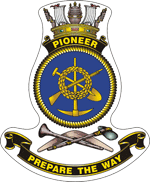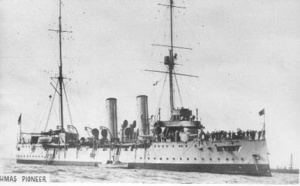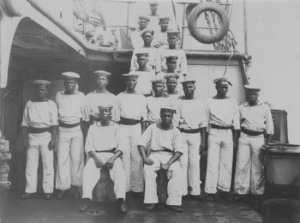HMAS Pioneer
| Class |
Pelorus Class |
|---|---|
| Type |
Light Cruiser (3rd Class Protected Cruiser) |
| Builder |
Chatham Dockyard, England |
| Laid Down |
16 December 1897 |
| Launched |
28 June 1899 |
| Commissioned |
1 March 1913 |
| Decommissioned |
7 November 1916 |
| Dimensions & Displacement | |
| Displacement | 2,200 tons |
| Length | 305 feet |
| Beam | 36 feet 6 inches |
| Draught | 17 feet |
| Performance | |
| Speed | 20 knots |
| Complement | |
| Crew | 224 |
| Propulsion | |
| Machinery | Inverted 3 cylinder triple expansion steam engines, 2 shafts |
| Horsepower | 5,000 |
| Armament | |
| Guns |
|
| Torpedoes | 2 x 14-inch torpedo tubes (above water) |
| Awards | |
| Battle Honours | GERMAN EAST AFRICA 1915-16 |

HMS Pioneer was commissioned by the Royal Navy on 10 July 1900.
Following a period in home waters, Pioneer proceeded on 15 November 1900 to the Mediterranean Station where she relieved the cruiser HMS Fearless. She served for four years in Mediterranean waters, returning to Chatham on 20 December 1904 where she was placed in Reserve.
She recommissioned on 5 September 1905 for service on the Australia Station as one of the ‘Drill Ships’ provided for under the Naval Agreement (1903) concluded between the Australian Commonwealth and the Imperial Government. Pioneer relieved HMS Mildura, her sister ships HMS Psyche and HMS Pyramus at the same time replacing HM Ships Katoomba and Phoebe.
The Australian Squadron commanded by Sir Arthur D Fanshawe KCB, then comprised HMS Powerful (Flagship, 14,200 tons), the second class cruisers HMS Cambrian (4360 tons) and HMS Encounter (5880 tons) and two other Pelorus class cruisers, HMS Pegasus and HMS Prometheus.
Pioneer continued in service as a unit of the Royal Navy on the Australia Station until 29 November 1912 when she paid off at Sydney for transfer to the Royal Australian Navy as a gift from the Admiralty. The Commonwealth Naval Board assumed control of her on 1 March 1913 and on the same day she commissioned in the Royal Australian Navy as HMAS Pioneer with a nucleus crew, as tender to HMAS Penguin.
In July 1913 refitting began at Garden Island, work which was not completed until the close of the year. On 1 January 1914 she commissioned as an independent command for service as a seagoing training ship for the Naval Reserve, operating under the orders of the Director of Naval Reserves. The months preceding the outbreak of World War I were spent in eastern and southern Australian waters, cruising from her base at Sydney to Melbourne, Adelaide and Hobart.
When war with Germany was declared on 4 August 1914, Pioneer was at Port Phillip Bay, Melbourne. The following day she sailed for Fremantle to operate on patrol on the Western Australian coast. Operations began on 16 August, and on that day, some eight miles west of Rottnest Island, Pioneer captured the German steamer Neumunster (4424 tons) and took her into Fremantle. On 26 August she captured a second ship, the 4994 ton Norddeutcher-Lloyd vessel Thuringen, also off Rottnest Island. Neumunster was taken over by the Commonwealth Government as a prize of war and renamed Cooee. Thuringen was renamed Moora and handed over to the Indian Government for service as a troopship.
On 4 September Pioneer proceeded from Fremantle on patrol to Darwin, calling at Port Hedland and Broome en route.
On 1 November 1914 Pioneer sailed as part of the escort to the First Australian Convoy comprising 38 transports but, just as she was taking up position between the Australian and New Zealand divisions, her engines broke down and the Flagship, HMS Minotaur, ordered her to return to Fremantle. Thus she probably missed encountering the German cruiser Emden instead of HMAS Sydney (I) as she was under orders to diverge from the convoy route to inspect the Cocos Islands.
On 24 December 1914 the Admiralty requested the aid of Pioneer as a blockading ship on the German East African coast, where the German cruiser Konigsberg had taken shelter up one of the mouths of the Rufigi River a few miles south of Zanzibar.
Sailing from Fremantle on 9 January 1915, Pioneer proceeded to the Cocos Islands, where as she coaled from her attendant collier her crew inspected the wreck of the Emden, destroyed by Sydney on 9 November 1914. After leaving the Cocos Islands, she proceeded to Diego Garcia in the Chagos Archipelago and then to Zanzibar which was reached on 6 February.
The Konigsberg at this period was sheltering up the Rufigi River beyond the range of effective fire from the sea but it was thought that she might attempt to break out. Thus the British forces at sea had a double duty; firstly the maintenance of a blockade to prevent supplies reaching German forces ashore in East Africa; and secondly the neutralisation of a dangerous warship which had already destroyed Pioneer’s sister ship Pegasus.
The force assembled for this task comprised Pioneer, the light cruisers HMS Weymouth and HMS Hyacinth, HMS Pyramus (another of Pioneer’s sister ships), the armed merchant cruiser Kinfauns Castle, four armed whalers, an armed steamer and an armed tug. Formal blockade was proclaimed on 1 March 1915 and five days later Vice Admiral King-Hall arrived in the old battleship HMS Goliath to take charge.
The East African coastline was for the purposes of operations, divided into three sections and Pioneer was allotted in charge of the northern most area from north of Tanga past the island of Zanzibar to a point just south of Dar-es-Salaam, with the armed steamer Duplex and the whaler Pickle.
With several attempts to drive Konigsberg from her lair having failed, it was decided to tow to the scene two monitors, HMS Severn and HMS Mersey, and taking advantage of their shallow draught, take them upstream within range of the enemy. The attack began on 6 July 1915 and while Hyacinth and Pioneer bombarded the area of the main (Simba Uranga) mouth of the river, the monitors steamed up the northern (Kikunya) arm, anchored and began firing alternate salvoes. Surgeon Lieutenant GA Melville-Anderson in Pioneer describing the scene recorded:
‘We approached very cautiously, and when we were about 5,000 yards from the river entrance, we dropped anchor and allowed the tide to swing us broadside on. Hence all our starboard guns bore on the entrance. Very soon we were firing salvoes and then each gun rapidly independently. Our shells were bursting everywhere, throwing up great clouds of sand and earth.
In the meantime they were steaming up the river under heavy fire from the banks, but they went on and soon were within range of the Konigsberg. They then began to fire, the range being about five miles. Aeroplanes assisted the monitors in locating the position but were not very successful. The Konigsberg fired salvoes of five guns with good accuracy but soon she dropped to four then to three and two and finally one. During the last hour-and-a-half of the engagement she ceased fire altogether.’
The monitors, however, failed to destroy the German cruiser and in her turn she hit Mersey’s foremost gun, killing six men. At 3:30pm and after firing 600 6-inch shells, both were withdrawn.
The operation was repeated on 12 July. This time Konigsberg straddled the Severn as she prepared to drop anchor, but Severn quickly got the range and hit the German several times, setting her on fire and forcing the enemy to complete demolition after removal of the guns.
Following the destruction of Konigsberg, Pioneer spent a period patrolling off the river mouth and later spent some time in the southern section of the blockade area. By the end of July she had been under way every day for more than six months except for nine days spent in harbour.
On 31 August 1915 she withdrew and proceeded to Simonstown for refit. Six weeks were spent in dock and on 22 October she proceeded to return to the patrol area, calling at Lorenzo Marquez, Beira, Mozambique, Port Amelia and Ibo en route.
Patrol was resumed in the southern section in November. The task involved routine patrolling with no enemy opposition and in the main it was uneventful, monotonous work. Two incidents occurring before the close of 1915 are nevertheless worth mentioning. Surgeon Lieutenant Melville-Anderson in his diary records that at 8:30 am on 20 November Pioneer landed fifty men on Mafia Island, off the East African coast, to witness the shooting of two Arabs.
‘These Arabs’, Melville-Anderson wrote, ‘had assisted some Germans to cross from the mainland under cover of night to obtain military information. They gave them shelter and native clothing, thus enabling them to get about the island undetected. But, they were discovered and the two Arabs, after being court-martialled, were sentenced to be shot. The sentence was carried out in the Market Place to impress the natives and we were drawn up in the Square. The Arabs were each bound to two upright poles, blind-folded and handcuffed and the firing party of Askaris (native troops) fired a volley. Another medical officer and myself examined them and considered life extinct in one, but not the other so it was decided to fire another volley.’
The second incident occurred on 20 December 1915. On that day, Pioneer anchored in Nazi Bay and sent a cutter away to obtain provisions. A hundred yards from the beach the cutter suddenly came under rapid fire from the shore. Two men were wounded before the boat could be brought about to pull back to the ship under the protection of 4-inch fire.
On Christmas Day 1915, Pioneer anchored in the Lindi River off the Lindi township. Lieutenant Melville-Anderson commented ‘As the day progressed, the Germans on shore signalled Christmas greetings and we reciprocated and added, “Send boat for presents”. They signalled back “Thank you, will try”, but for some unexplained reason no boat came from the shore. The day was a merry one and in the dogwatches we proceeded to sea for Mombasa.’
In the twelve months ending 9 January 1916 Pioneer steamed 29,434 miles, was under way on 287 days and consumed 7,496 tons of coal. She coaled on an average every ninth day (39 coalings) from a total of 17 colliers. She was sixty eight days in harbour including thirty six days under refit.
Early in February 1916, in fulfilment of a promise made to the Australian Government, the Admiralty ordered Pioneer back to Australian waters. But on 13 February General Smuts assumed command of the East African campaign and his plans demanded more naval cooperation than had previously been envisaged. As a result, when the new flagship HMS Vengeance (Rear Admiral E Charlton RN) arrived at Mombasa on 23 February 1916, Pioneer’s crew learnt that the order to return home had been cancelled. Next day she sailed for Zanzibar to resume operations on the southern patrol.
Four weeks on patrol ended on 22 March 1916 when Pioneer arrived off Dar-es-Salaam, the capital of German East Africa, where the enemy had a so called ‘hospital ship’ named Tabora which was suspect. The following day Vengeance and Hyacinth arrived and after the latter had been refused permission to send an inspection party on board, Pioneer was ordered to close in and open fire if any movement was detected among the ships in harbour. She fired a few rounds of 4-inch ammunition then ceased while Vengeance awaited the results of a signal ordering the Germans to evacuate their sick from Tabora. With no answer forthcoming, fire was opened by all three ships and the ‘hospital ship’ destroyed.
At the beginning of April 1916 Pioneer transferred to the northern patrol, north of Tanga to Ras Kanzi, for a month’s tour of duty. In May she returned to the southern section and back north in June. On 13 June she and HMS Challenger bombarded Tanga and the following month once more on patrol in the south, she took part in the attack on Dar-es-Salaam with Vengeance and Hyacinth. This activity was due to the advance of British forces on land. The naval bombardment of Tanga was a prelude to its capture on 7 July and that of Dar-es-Salaam its seizure by sea and land forces on 7 September.
The 100 rounds of 4-inch ammunition fired by Pioneer on 30 July was the last fired by her against the enemy. On 8 August she received a signal ordering her withdrawal to Australia.
On 22 August 1916 Pioneer sailed from Zanzibar flying her paying off pennant. She reached Colombo on 5 September, Batavia on 21 September, Darwin on 4 October and Sydney on 22 October. She paid off at Sydney on 7 November 1916, bringing her seagoing career to a close.
Thereafter she was used as an accommodation ship at Garden Island until 1922. In May 1923 she was handed over to Cockatoo Dockyard by the Disposals Board. In 1924 she passed to the control of Commonwealth Shipping Board and during the same year the work of stripping her down to a bare hull was begun. Pioneer’s hull was bought by HP Stacey of Sydney as scrap. The bare hull was scuttled off Sydney on 18 February 1931.
Further reading
Semaphore - Issue 12, July 2005, Blockading German East Africa, 1915-16.






